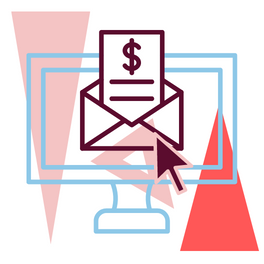
Having a great database of email subscribers is absolutely invaluable to any business. The quality of your contacts determines the success of your email marketing campaigns and your communication with your client base and target audience, driving brand awareness, customer engagement and, ultimately, sales.
When we talk about email subscribers, we essentially mean those people who want to hear from you. People who have indicated a genuine interest in your products or services already or those who represent your target audience. Businesses don’t always get email communication right but there are lots of ways to improve your interactions with customers and potential customers alike.
Let’s take a look at 5 ways you can send your email open rate into the stratosphere!
First, it is probably useful to establish what we mean by a good email open rate. If we look at the stats, 17%-28% is considered pretty healthy. If you’re not reaching this percentage range, your email recipients probably don’t value your content.
Getting people to open your emails is key to selling your products and services in 2022. However, the question is what really encourages people to open an email from a business? In this post, we’re going to highlight five powerful tactics that will help you increase your email open rate in 2022:

1. Write enticing email subject lines
Your subscribers probably receive tons of emails every day. If you want them to open your email, you must create tempting subject lines. Be creative! Ensure that your audience stops scrolling when they see your email.
Why is it important to write a strong, curiosity-piquing subject line? Because it encourages people to click and see what’s in there. For example, asking an interesting question could make people open up an email.
If you take a quick look at your inbox, you’re likely to find plenty of emails with generic, salesy subject lines. Your goal should be to stand out from the crowd and offer clear value.
Throw in a little humor or use buzzwords that resonate with your audience. Here are some examples of good email subject lines:
● You wouldn’t believe I did this
● A surprise gift for you
● 30% off your favorites
● The price dropped for something in your cart
● Can I buy you a coffee?
Try to be creative and don’t hesitate to test your ideas. If a certain subject line is working well for you, stick to it. But make sure to be short and concise.
A quick tip: Think of email subject lines that would make you open an email.


2. Email your audience at least once a week
You’ve probably heard people saying that businesses shouldn’t send too many emails. This is true to some extent. However, you don’t want to be a stranger in your customers’ inboxes. The more familiar your brand name becomes, the more likely they are to open your emails.
As a business, you can easily put customers off by emailing them too frequently. However, if you keep your emails meaningful or helpful, your audience will keep opening them. The objective here is to stay in front of their mind. If you email at least once a week, your brand name will stay recognizable.
Consider increasing the frequency of your communications if you’ve got promotional offers, great content, or ever-changing promotions. Stats tell us that a majority of marketers send emails 2-3 times a month. Timing can be everything when it comes to improving your click-through rate.

3. Offer value in every single email you send
One of the best things you can do to ensure your audience opens every single email you send is to provide undeniable value. When brands relentlessly send boring, pushy emails, eventually people stop reading them. Avoid this happening to your email marketing campaign. In other words, don’t send emails for the sake of sending emails.
People will be waiting for your email when they trust they will offer some sort of benefit. So, try to be the name your audience loves to see in their inbox instead of a name that people want to unsubscribe. Here are some suggestions on how to earn the trust of your audience:
• Tell interesting stories and relate them to other content such as blog posts or articles.
• Talk about a problem your audience is likely to be facing and then explain how your products or services can fix it.
• Let your audience know if you’re being featured somewhere.
• When creating content for marketing campaigns such as email marketing, focus on how your audience would feel after reading or watching a particular piece of content. Make them feel good.
• In your email copy, include a sense of urgency. It is useful to include dynamic content to make your A/B testing process easier.

4. Segment and clean your email list
How many people in your email lists are really interested in your content or products? To keep your email KPIs strong, you need a clean email database to keep your engagement level high.
Spend some time segmenting and cleaning your data. Remove subscribers that are no longer interested in your content. This will help you lower unsubscribe and spam rates. If people are constantly labeling your emails as spam, then your email service provider might flag your account for sending unwanted content.
Before you spring clean your email list, identify whether a subscriber is simply disengaged or truly inactive. There’s nothing wrong with removing inactive subscribers. However, you can still reinvigorate the disengaged ones. Consider sending them some highly personalized emails to refresh their interest in your content.
A good list scrub is necessary to improve your email open rate. Most email service providers help their users pull reports that segment highly engaged subscribers and identify those who don’t open your email anymore. With an email list of truly engaged subscribers, you have a chance to hit a good open rate mark.

5. Use a recognizable sender name
The sender name you use for your emails plays a significant role in boosting or reducing open rates. While the subject line is key, don’t overlook the importance of the sender’s name. Why? Because 42% of people are likely to look at the sender’s name before opening it. On mobile devices, the sender name is probably the first thing people see when they check their inboxes.
Ideally, the sender’s name should be a real name. It could be your personal name or your company’s name. But it shouldn’t be generic like ‘info@companyname.com. Also, it helps to be consistent with your sender name.
Closing thoughts
Mailchimp found that the average open rate for all industries was 21.33%. Whatever the open rates of your campaigns are, you can always do something to boost the figures. Sending the right message to the right audience at the right time will help you dramatically improve the overall results of your email marketing campaigns.

